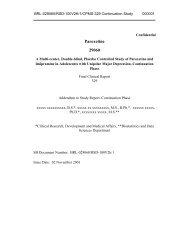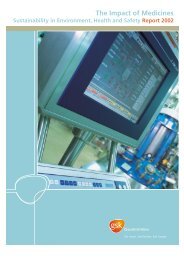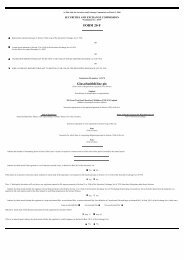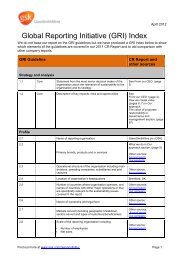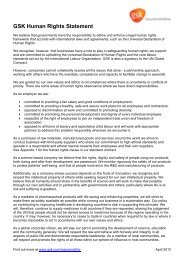GSK Annual Report 2002
GSK Annual Report 2002
GSK Annual Report 2002
Create successful ePaper yourself
Turn your PDF publications into a flip-book with our unique Google optimized e-Paper software.
12 GlaxoSmithKline Description of business<br />
Over the last decade, regulatory authorities have focused<br />
significant attention on measures to manage the risk associated<br />
with the use of prescription products. This is particularly noticeable<br />
in the USA, where the FDA and the pharmaceutical industry have<br />
been subjected to intense public scrutiny of the adequacy of<br />
measures taken to protect the public health. Substantial funding<br />
for the FDA to strengthen post market surveillance activities was<br />
included under PDUFA III. Under performance goals associated<br />
with the legislation, drug manufacturers are encouraged to submit<br />
voluntarily proposed Risk Management Plans as part of applications<br />
for marketing new drugs. These recent developments represent an<br />
additional challenge to the market registration process in the USA.<br />
On 7th June <strong>2002</strong>, the FDA announced approval of a supplemental<br />
New Drug Application (sNDA) that allows restricted marketing of<br />
Lotronex (alosetron hydrochloride) to treat only women with severe<br />
diarrhoea-predominant irritable bowel syndrome (IBS). The<br />
November <strong>2002</strong> reintroduction followed an advisory committee<br />
review and implementation of a FDA-GlaxoSmithKline agreed risk<br />
management programme intended to ensure patients and<br />
physicians are fully informed of possible risks and benefits of<br />
Lotronex.<br />
Across International markets, countries outside the USA and<br />
Europe, the regulatory environment continues to be extremely<br />
varied and challenging. GlaxoSmithKline anticipates that the<br />
introduction of new products will continue to require substantial<br />
effort, time and expense to comply with regulatory requirements.<br />
Price controls<br />
In many countries the prices of pharmaceutical products are<br />
controlled by law. Governments may also influence prices through<br />
their control of national healthcare organisations, which may bear<br />
a large part of the cost of supplying products to consumers.<br />
In the USA, debate over the reform of the healthcare system has<br />
increased the focus on pricing. Currently there are no government<br />
price controls over private sector purchases, but federal legislation<br />
requires pharmaceutical manufacturers to pay prescribed rebates<br />
on certain drugs in order to be eligible for reimbursement under<br />
Medicaid and other federal healthcare programmes.<br />
In Europe, historically affected by government regulation in pricing<br />
and reimbursement, the pharmaceutical industry continues to<br />
experience pressure on its prices through a range of measures,<br />
including across-the-board cuts, linking to low-cost countries, price<br />
referencing and delays in agreeing reimbursement. There is an<br />
increasing pressure for generic substitution and cross-border<br />
imports from low-priced markets may exert a commercial pressure<br />
on in-country pricing.<br />
In Japan, discussions are ongoing as to which new price and<br />
reimbursement controls the government will introduce.<br />
During <strong>2002</strong>, the worldwide pharmaceutical market continued to<br />
experience increasing pressure on pricing and reimbursement from<br />
governments and healthcare providers, though it is non-price<br />
factors, new products and higher volumes, which are principally<br />
driving the growth of pharmaceutical expenditure.<br />
Value for money<br />
It is becoming increasingly necessary to demonstrate the value for<br />
money of new products, in particular the impact upon drug<br />
budget expenditure and the burden of the disease that will be<br />
treated.<br />
In some markets, the need to satisfy healthcare purchasers as to<br />
value for money is becoming an additional hurdle for product<br />
acceptance over and above the regulatory tests of safety, efficacy<br />
and quality. This can delay bringing effective and improved<br />
medicines to the market and reduce their effective patent<br />
protection time.<br />
In many markets it is becoming increasingly difficult for a<br />
significantly improved therapy to obtain a premium price over<br />
existing medication. Philosophies founded on value-based pricing<br />
are difficult to follow in such circumstances although in the USA<br />
it is still possible to price products to reflect their value.<br />
It is not possible to predict whether, and to what extent, the<br />
Group’s business may be affected by future legislative and<br />
regulatory developments relating to specific pharmaceutical<br />
products or their price.<br />
Regulation – Consumer Healthcare<br />
The consumer healthcare industry is subject to national regulation<br />
for the testing, approval, manufacturing, labelling and marketing<br />
of products. In many countries high standards of technical<br />
appraisal entail a lengthy approval process before a new product<br />
is launched.<br />
National regulatory authorisation is also required to approve the<br />
switch of products from prescription to OTC. The requirements<br />
include long-term experience of the quality, safety and efficacy<br />
of the product in a wide patient population and data to confirm<br />
that the relevant condition is both self-limiting and can easily be<br />
diagnosed by the consumer.








